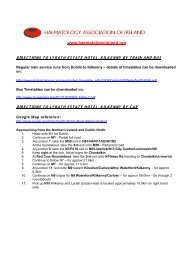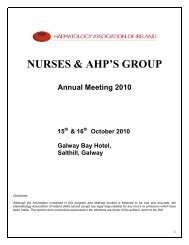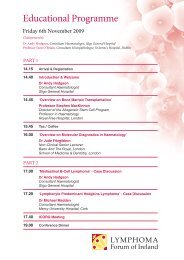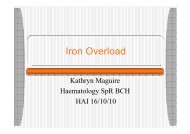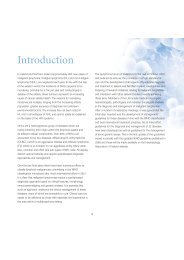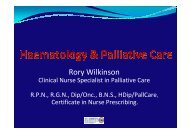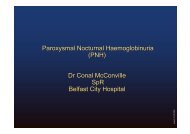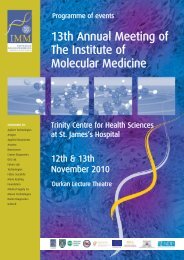Guidelines on Diagnosis and Treatment of Malignant Lymphomas
Guidelines on Diagnosis and Treatment of Malignant Lymphomas
Guidelines on Diagnosis and Treatment of Malignant Lymphomas
You also want an ePaper? Increase the reach of your titles
YUMPU automatically turns print PDFs into web optimized ePapers that Google loves.
Classificati<strong>on</strong> system<br />
The World Health Organizati<strong>on</strong> (WHO) classificati<strong>on</strong> <strong>of</strong><br />
neoplastic diseasesTumours <strong>of</strong> the haematopoietic <strong>and</strong> lymphoid<br />
tissues, 4th editi<strong>on</strong> 2008 should be used.<br />
Diagnostic requirements for<br />
haematopathology diagnosis<br />
The diagnosis <strong>of</strong> lymphoma should be made, or reviewed, in a<br />
laboratory with the necessary specialist expertise <strong>and</strong> facilities.<br />
A pathology laboratory diagnosing lymphoma requires access to<br />
the following resources:<br />
a. Morphological expertise: Pathologists/haematologists<br />
involved in lymphoma diagnosis should have the necessary<br />
training to undertake this work.<br />
b. Immunophenotyping: All marker studies should be<br />
carried out using panels designed to test the validity <strong>of</strong> the<br />
morphological diagnosis <strong>and</strong> to dem<strong>on</strong>strate key prognostic<br />
variables. Marker studies should be carried out using flow<br />
cytometry <strong>and</strong> immunohistochemistry. An appropriate panel<br />
for the lymphoma sub-types is included in the lymphomaspecific<br />
secti<strong>on</strong>s in this document.<br />
c. Molecular techniques: The two main techniques are<br />
polymerase chain reacti<strong>on</strong> (PCR) to detect m<strong>on</strong>ocl<strong>on</strong>ality<br />
<strong>and</strong> some translocati<strong>on</strong>s, <strong>and</strong> fluorescence in situ<br />
hybridisati<strong>on</strong> (FISH) techniques for translocati<strong>on</strong>s.<br />
These techniques should be used to c<strong>on</strong>firm a provisi<strong>on</strong>al<br />
diagnosis <strong>and</strong> identify prognostic factors. Formal links with<br />
a molecular/cytogenetics service are required.<br />
d. Integrated reporting: Most patients with<br />
lymphoproliferative disorders have different specimens taken<br />
during their clinical course. Departments should have a<br />
mechanism for correlating results from lymph node biopsies,<br />
b<strong>on</strong>e marrow aspirates <strong>and</strong> biopsies as well as different<br />
analyses <strong>of</strong> a single sample.<br />
Reporting<br />
A preliminary report should be available 5 working days after the<br />
specimen is received. This interim report should state specific<br />
outst<strong>and</strong>ing investigati<strong>on</strong>s <strong>and</strong> be followed by a definitive report.<br />
Quality assurance <strong>and</strong> audit<br />
The main comp<strong>on</strong>ent <strong>of</strong> quality assurance is access to a robust<br />
<strong>and</strong> timely diagnostic process. An audit system designed to test<br />
the quality <strong>of</strong> the service should be in place. Laboratories should<br />
be able to provide users <strong>of</strong> the laboratory with details <strong>of</strong> their<br />
diagnostic criteria <strong>and</strong> technical methods.<br />
Laboratories should participate in the relevant quality assurance<br />
schemes for immunocytochemistry, flow cytometry <strong>and</strong> other<br />
diagnostic methods. Individual histopathologists should have<br />
access to a lymphoma review panel.<br />
<strong>Diagnosis</strong> –<br />
laboratory procedures <strong>and</strong> st<strong>and</strong>ards<br />
■ Unfixed node biopsy imprint preparati<strong>on</strong> –<br />
formalin preparati<strong>on</strong> <strong>of</strong> material, snap freezing <strong>and</strong><br />
disaggregati<strong>on</strong> into single-cell suspensi<strong>on</strong><br />
■ WHO classificati<strong>on</strong><br />
■ Access to immunophenotyping, molecular<br />
techniques <strong>and</strong> molecular genetic techniques<br />
■ Preliminary report within 5 working days<br />
■ Systems <strong>of</strong> quality assurance in place: St<strong>and</strong>ard<br />
Operating Procedures (SOPs); Lab Accreditati<strong>on</strong>;<br />
Nati<strong>on</strong>al Quality Assurance Scheme<br />
■ Access to review panel<br />
Multidisciplinary team (MDT) working<br />
MDT meetings are a desirable part <strong>of</strong> the diagnosis <strong>and</strong><br />
management <strong>of</strong> lymphoma. The arrangements will vary with local<br />
circumstances but it is essential that diagnostic pathology <strong>and</strong><br />
staging radiology be reviewed in both new <strong>and</strong> relapsed patients<br />
before making a management plan. This plan should be clearly<br />
documented in patients’ notes.<br />
3




